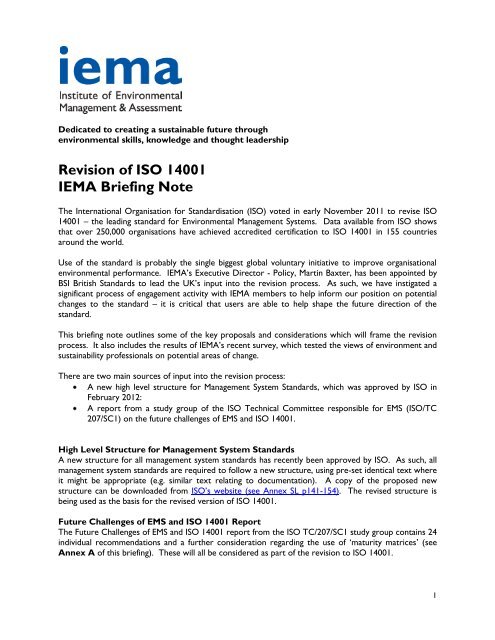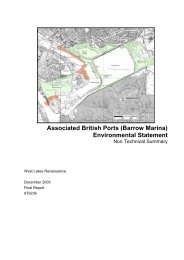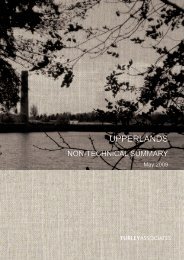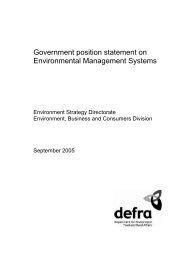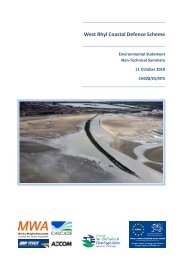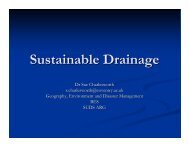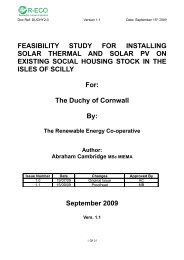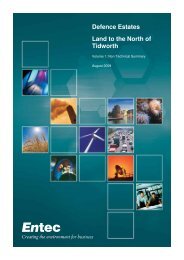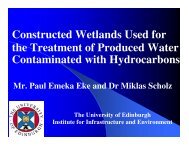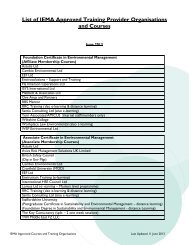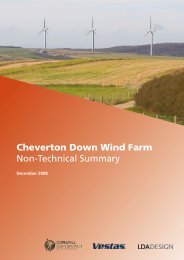Revision of ISO 14001 IEMA Briefing Note
Revision of ISO 14001 IEMA Briefing Note
Revision of ISO 14001 IEMA Briefing Note
Create successful ePaper yourself
Turn your PDF publications into a flip-book with our unique Google optimized e-Paper software.
<strong>IEMA</strong> Survey on <strong>Revision</strong> to <strong>ISO</strong> <strong>14001</strong> – 1,651 completed questionnairesStronglyDisagreeDisagreeAgreeStronglyAgreeTotalAgreeThe revision to <strong>ISO</strong> <strong>14001</strong> should require the EMS to be linked / integrated to the strategic decisionmaking processes <strong>of</strong> the organisation.The revision to <strong>ISO</strong> <strong>14001</strong> should require organisations to consider impacts from a changingenvironment that are relevant to their organisation, in addition to organisational impacts on theenvironment.The revision to <strong>ISO</strong> <strong>14001</strong> should place greater emphasis on the management <strong>of</strong> impacts across the lifecycle <strong>of</strong> products / services provided and used.The revision to <strong>ISO</strong> <strong>14001</strong> should seek to position environmental management in the context <strong>of</strong>sustainable development.The revision to <strong>ISO</strong> <strong>14001</strong> should strengthen and clarify how organisations demonstrate their‘commitment to legal compliance’.The revision to <strong>ISO</strong> <strong>14001</strong> should require organisations to periodically demonstrate their knowledgeand understanding <strong>of</strong> their compliance status.The revision to <strong>ISO</strong> <strong>14001</strong> should require organisations to demonstrate continual improvement <strong>of</strong>their EMS and the environmental outcomes that they achieve.The revision to <strong>ISO</strong> <strong>14001</strong> should require organisations to evaluate their environmental performancethrough the use <strong>of</strong> defined indicators which the organisation would be free to determine.<strong>ISO</strong> <strong>14001</strong> should support the provision <strong>of</strong> information on environmental performance which anorganisation is required, or may decide, to report or disclose.Guidance in <strong>ISO</strong> <strong>14001</strong> should refer to other relevant standards which can help with the achievement<strong>of</strong> the aims <strong>of</strong> the EMS (e.g. <strong>ISO</strong> 14031 – Environmental Performance Evaluation).The principal aim <strong>of</strong> <strong>ISO</strong> <strong>14001</strong> is to provide a framework through which organisations can deliverimprovements in their environmental performance.Maturity matrices should be included in the annex <strong>of</strong> <strong>ISO</strong> <strong>14001</strong> (as guidance) to help organisationstrack and plan the development <strong>of</strong> the EMS, in order to continually deliver improvements inperformance.1.2% 4.1% 51.5% 43.2% 94.7%2.0% 9.6% 56.6% 31.9% 88.5%2.0% 13.7% 52.6% 31.7% 84.3%1.9% 7.5% 52.8% 37.8% 90.6%1.1% 6.8% 47.5% 44.6% 92.1%1.1% 9.0% 53.4% 36.4% 89.8%0.5% 7.1% 55.6% 36.8% 92.4%0.9% 9.3% 60.5% 29.3% 89.8%1.0% 9.1% 63.3% 26.6% 89.9%1.6% 7.6% 58.0% 32.7% 90.8%0.4% 6.3% 55.3% 38.0% 93.3%1.7% 9.9% 64.4% 23.9% 88.3%3
Annex ARecommendations for the <strong>Revision</strong> <strong>of</strong> <strong>ISO</strong> <strong>14001</strong> from the EMS Future ChallengesReport"When considering new requirements in a revised version <strong>of</strong> <strong>ISO</strong> <strong>14001</strong>, it should be remembered that <strong>ISO</strong><strong>14001</strong> is a tool to improve environmental management; new requirements should not be set in such way thatthey only reflect 'best in class' levels that will dissuade or exclude entry level organizations from adopting thisstandard. The use <strong>of</strong> ‘maturity matrices’ should be considered to show how requirements can be applied in anincreasingly comprehensive manner.”Maturity matrices are already a part <strong>of</strong> BS 8900: 2006 Guidance for Managing Sustainable Development,which allows organisations to pr<strong>of</strong>ile the maturity <strong>of</strong> the management system and identify areas <strong>of</strong>weakness.An example <strong>of</strong> how a maturity matrix might apply within <strong>ISO</strong> <strong>14001</strong> is shown below although it wouldbe the responsibility <strong>of</strong> individual organisations to prepare their own maturity matrix to ensure it isrelevant to them:ManagementSystem CriteriaSystem MaturityNewly EstablishedFully EmbeddedTraining andAwareness RaisingBasic environmentalawareness provided;further training providedas required.Frequent awarenessraising programmes run;specific training needsevaluated periodically.Continual awarenessraising programmes andstaff engagement; stafftraining needscontinually assessed andmet, including planningfor future needs andcapacity.The 24 specific recommendations which will be considered in the revision process <strong>of</strong> <strong>ISO</strong> <strong>14001</strong> are setout below with some further explanation <strong>of</strong> some recommendations in italics. <strong>IEMA</strong> has grouped theseinto related areas to aid discussionsContext <strong>of</strong> Sustainable Development1. Put environmental management more clearly in the perspective <strong>of</strong> contributing to sustainabledevelopment (the ‘planet pillar’ <strong>of</strong> SR). This does not mean incorporating requirements from other nonenvironmentalaspects <strong>of</strong> sustainable development (i.e. people and pr<strong>of</strong>it pillars) into the standard, but to recognisethat an EMS is a tool used to address the ‘planet pillar’, <strong>of</strong>ten taken as part <strong>of</strong> wider action on sustainabledevelopment and social responsibility in organisations.2. Address life cycle thinking* and the value chain perspective more clearly in the identification &evaluation <strong>of</strong> environmental aspects related to products and services. *this does not meanimposing LCA.3. Consider addressing other environmental principles from <strong>ISO</strong> 26000, clause 6.5. Some principlesfrom <strong>ISO</strong> 26000 are inherent to EMS implementation in line with <strong>ISO</strong> <strong>14001</strong> (e.g. environmental risk management) but others,(e.g. the precautionary approach and polluter pays) are not and could be addressed in the revision.4. Consider aligning language between <strong>ISO</strong> 26000 (Social Responsibility) and <strong>ISO</strong> <strong>14001</strong>.N.B. <strong>ISO</strong> 26000 (Guidance on social responsibility) is a guidance standard (i.e. not a management system standard whichcan be audited against) which provides overarching guidance on what is meant by social responsibility, including definitions,principles and covering the core subjects that should be addressed. The standard addresses social responsibility through4
seven core subjects, namely: organisational governance, human rights, labour practices, the environment, fair operatingpractices, consumer issues and community involvement and development.Strategic Application5. Strengthen (on a strategic level) the relationship between environmental management and thecore business <strong>of</strong> organizations, i.e. its products and services and the interaction withstakeholders (including clients and suppliers). This would aim to move the EMS from what is <strong>of</strong>ten an operationallevel only tool to one which has greater influence on the overall business management <strong>of</strong> the organisation.6. Use the JTCG identical text on ‘context <strong>of</strong> the organization’ to strengthen link betweenenvironmental management and the organization's overall strategic considerations. This refers toSection 4 in the proposed High Level Structure with identical text for Management System Standards, which reads, “Theorganization shall determine external and internal issues that are relevant to its purpose and that affect its ability to achieve theintended outcomes <strong>of</strong> its XXX management system”.7. Consider the implications <strong>of</strong> new (strategic) business management models for application <strong>of</strong> <strong>ISO</strong><strong>14001</strong>8. Pay attention to strategic considerations <strong>of</strong> environmental management, the benefits andopportunities <strong>of</strong> it for organizations, not only in the introduction, but also in the requirementsStrengthen Requirements9. Strengthen performance evaluation as part <strong>of</strong> 4.5.1 in <strong>ISO</strong> <strong>14001</strong> (e.g. use <strong>of</strong> indicators);consider in this respect the ways in which performance evaluation is addressed in <strong>ISO</strong> 14031, in<strong>ISO</strong> 50001 and in non-<strong>ISO</strong> sources such as EMAS III and GRI.10. Strengthen attention for subjects such as:a. Transparency/accountability with respect to environmental management/issues/performanceb. Value chain influence/responsibility11. Consider to include the concept <strong>of</strong> demonstrating knowledge and understanding <strong>of</strong> theorganization’s compliance status. This refers to the legal compliance status <strong>of</strong> the organisation.12. Address the concept <strong>of</strong> 'demonstration <strong>of</strong> the commitment to legal compliance'. There are currentlydifferent views on what the requirement for ‘commitment to compliance’ should deliver in practice in certified EMS’s- thisvariance could be addressed in the revision.13. Building upon the (draft) JTCG identical text introduce a more systematic approach foridentification <strong>of</strong>, consultation and communication with stakeholders on environmental issues14. The future revision <strong>of</strong> <strong>ISO</strong> <strong>14001</strong> should address a requirement to establish an externalcommunication strategy, including communication objectives, identifying relevant interestedparties, description <strong>of</strong> what and when to communicate. This does not necessarily mean that externalcommunication will be a requirement <strong>of</strong> <strong>ISO</strong> <strong>14001</strong>, but that the current requirement to “decide whether to communicateexternally about its significant environmental aspects” could be enhanced to promote external communication.15. Clarification <strong>of</strong> the requirements <strong>of</strong> (improving) environmental performance in <strong>ISO</strong> <strong>14001</strong>.Accessibility16. An organization should retain the responsibility to align its <strong>ISO</strong> <strong>14001</strong> processes with itsenvironmental and business priorities.17. Maintain the applicability <strong>of</strong> <strong>ISO</strong> <strong>14001</strong> to SMEs, e.g. by drafting/maintaining simple andunderstandable requirements.18. Consider the guidance given in CEN Guide 17 “Guidance for writing standards taking intoaccount micro, small and medium-sized enterprises (SMEs) needs”Language and Clarity19. Draft clear and unambiguous requirements in <strong>ISO</strong> <strong>14001</strong>20. Clearly describe and communicate the approach/mechanism <strong>of</strong> achieving legal compliance in <strong>ISO</strong><strong>14001</strong> (e.g. in the Annex)21. Broaden/clarify the concept <strong>of</strong> Prevention <strong>of</strong> Pollution5
Guidance22. Provide where necessary clearer guidance in Annex A (according to its current aim: to preventmisinterpretation <strong>of</strong> the requirements)23. Provide guidance in the Annex on information related to environmental aspects <strong>of</strong> products andservices to external interested parties.24. Include clear requirements/guidance related to strategic environmental considerations, design &development, purchasing, market & sales activities in alignment with organizational prioritiesFurther Information:<strong>ISO</strong> <strong>14001</strong> - http://www.iso.org/iso/home.htmlEMS web-portal: www.iema.net/ems<strong>IEMA</strong>’s activities and evidence base used to develop this position statement can be found atwww.iema.net/iso<strong>14001</strong>Contact <strong>IEMA</strong> about <strong>ISO</strong><strong>14001</strong>:Martin BaxterExecutive Director – Policym.baxter@iema.netJosh FothergillPolicy & Practice Lead – EMSj.fothergill@iema.netPost: St Nicholas House, 70 Newport,Lincoln, LN1 3DP, UKTelephone: +44 (0)1522 540 069Further information about <strong>IEMA</strong>:For further information about <strong>IEMA</strong> and our activities on environmental skills, knowledge and thoughtleadership, visit:Web: www.iema.netLinkedIn: www.iema.net/linkedin6


